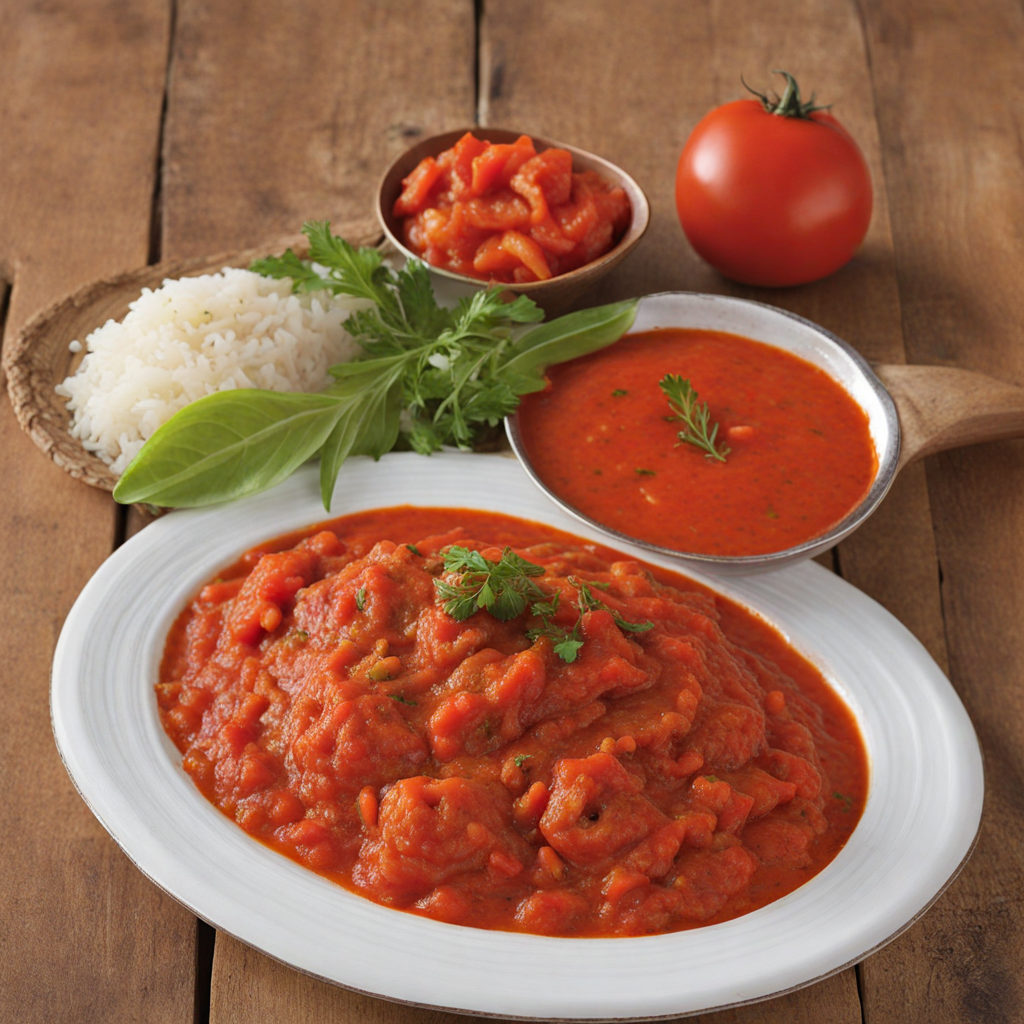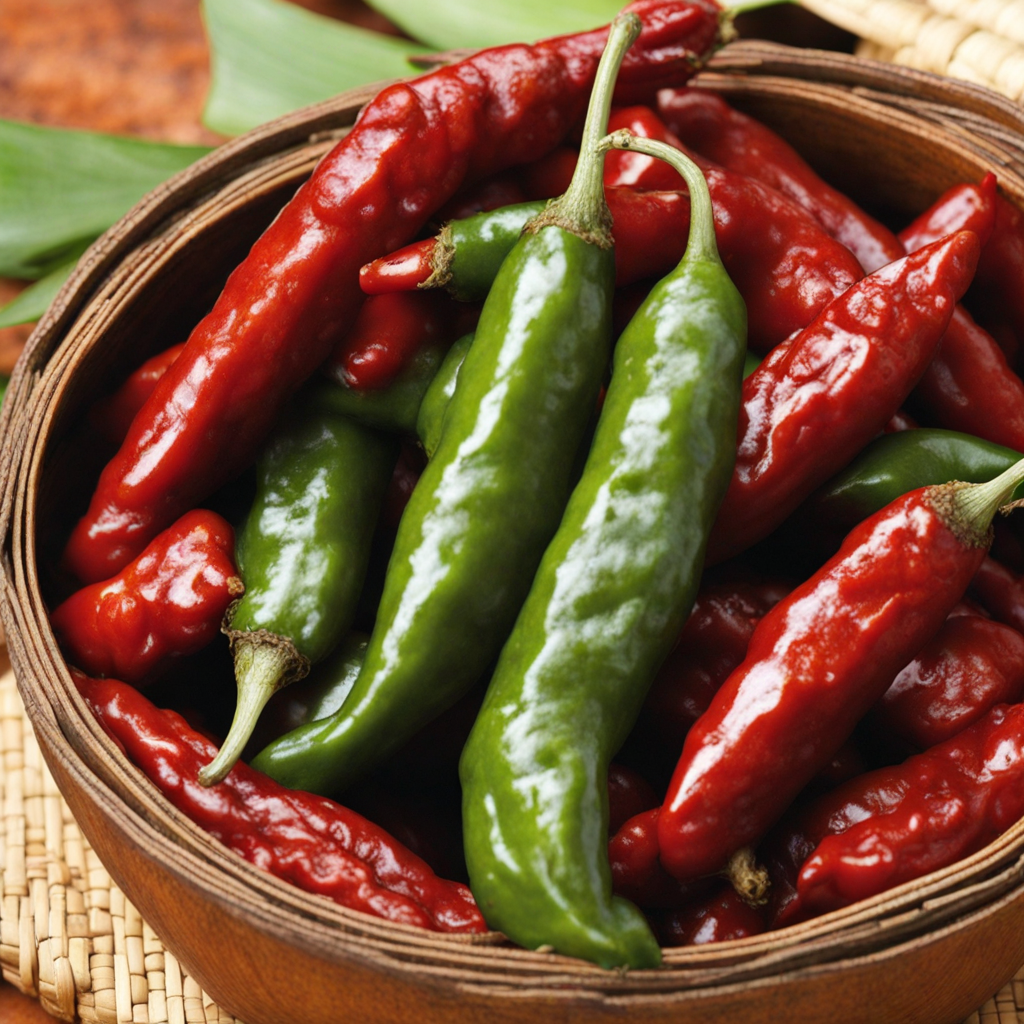Rougaille
Rougaille is a vibrant and aromatic dish that hails from the sun-kissed shores of Mauritius, reflecting the island's rich cultural tapestry. At its core, Rougaille is a tomato-based stew that celebrates the bold flavors of the region. The foundation of the dish is ripe, juicy tomatoes, often sautéed with onions, garlic, and a medley of spices such as turmeric, cumin, and coriander, creating a base that is both savory and slightly tangy. This aromatic concoction is then enhanced with fresh herbs like cilantro or thyme, adding a layer of freshness that elevates the dish’s complexity. Typically, Rougaille is prepared with proteins such as fish, chicken, or even lentils for a vegetarian option, allowing for a variety of taste experiences. The protein is simmered in the rich tomato sauce, absorbing all the vibrant flavors while becoming tender and succulent. The dish is often served with fluffy rice or crusty bread, making it a hearty and satisfying meal that invites you to indulge in its comforting warmth. The combination of the spicy sauce and the protein creates a delightful balance that dances on the palate, embodying the essence of Mauritian cuisine. One of the most enticing aspects of Rougaille is its versatility; it can be tailored to suit different tastes and dietary preferences. Whether you prefer a seafood version featuring fresh fish or a meatier take with chicken, each variation offers a unique twist on the classic dish. The use of local ingredients, such as fresh vegetables and herbs, not only enhances the flavor but also pays homage to the island's agricultural bounty. Rougaille is more than just a meal; it's a culinary journey that captures the spirit of Mauritius through its vibrant colors and bold flavors, inviting food lovers to explore a taste that is as rich as the culture itself.
How It Became This Dish
Rougaille: A Culinary Tapestry of Mauritius Origins: The Melting Pot of Influences Rougaille is a traditional dish from Mauritius that embodies the island's rich culinary heritage, shaped by centuries of migration, trade, and cultural exchange. Situated in the Indian Ocean, Mauritius has been a crossroads for various civilizations, including the Dutch, French, British, and Creole people. Each of these cultures has left its mark on the island's gastronomy, and rougaille is a quintessential representation of this fusion. The dish's name is derived from the French word "rougaille," which refers to a sauce made from tomatoes, onions, and spices. This sauce is the backbone of the dish, often featuring alongside a protein such as fish, chicken, or sausage. While the exact origins of rougaille are difficult to pin down, it is widely believed that the dish has its roots in Creole cuisine, which itself draws heavily from African, French, Indian, Chinese, and other culinary traditions. Cultural Significance: A Symbol of Unity Rougaille is more than just a meal; it is a symbol of cultural unity and shared history in Mauritius. The island's diverse population, comprising Indo-Mauritians, Franco-Mauritians, Creoles, and Sino-Mauritians, has contributed to a rich tapestry of flavors and cooking techniques. Rougaille serves as a reminder of this blend, as it is commonly prepared during family gatherings, community celebrations, and festivals. One of the most notable aspects of rougaille is its adaptability. Each community has its own variation of the dish, reflecting local ingredients and individual tastes. For example, the Creole version may include spicy sausages or fish, while Indo-Mauritians may prepare a vegetarian variant with lentils or chickpeas. This adaptability makes rougaille a dish that not only showcases the flavors of the island but also the harmony among its diverse inhabitants. Development Over Time: A Culinary Evolution As Mauritius transitioned through various colonial phases, so too did the preparation and presentation of rougaille. In the early days, the dish was primarily a home-cooked staple, prepared using seasonal ingredients sourced from local markets. The use of fresh herbs, spices, and vegetables was paramount, reflecting the island's rich agricultural practices. With the advent of the British colonial period in the 19th century, the influence of British cuisine began to seep into Mauritian cooking. This era introduced new ingredients such as potatoes and carrots, which were often incorporated into rougaille. While the traditional tomato-based sauce remained, these additional components added texture and flavor, allowing for greater creativity in the kitchen. As Mauritius moved into the 20th century, the food scene began to evolve further. The post-colonial era saw a resurgence of interest in local culinary traditions, with chefs and home cooks alike experimenting with classic recipes. Rougaille became a dish that was not only cherished in homes but also began making its way onto restaurant menus, gaining recognition as a staple of Mauritian cuisine. In contemporary times, rougaille has continued to evolve. Chefs have taken creative liberties with the dish, incorporating influences from international cuisines while maintaining its essential character. For instance, fusion variations may include elements from Italian, Thai, or even modern molecular gastronomy, offering a fresh take on this beloved classic. The Ingredients: A Symphony of Flavors The core of rougaille lies in its ingredients. The basic rougaille sauce is made from ripe tomatoes, onions, garlic, and a blend of spices such as turmeric, cumin, and chili. These ingredients are sautéed together until they create a rich, fragrant base. The choice of protein varies, with fish being particularly popular due to the island's fishing heritage. The use of local fish, such as snapper or tuna, ensures that the dish stays true to its roots. In addition to the traditional ingredients, many cooks have begun to incorporate local produce, reflecting the island's agricultural bounty. This may include fresh herbs like coriander and thyme, as well as seasonal vegetables such as bell peppers or eggplants. The result is a dish that is not only flavorful but also vibrant and visually appealing. Rougaille Today: A Culinary Icon Today, rougaille stands as an iconic dish of Mauritius, representing the island's culinary identity on both local and international stages. It is commonly served alongside rice, flatbreads, or lentils, making it a versatile and satisfying meal. In restaurants, rougaille is often presented with an emphasis on presentation and creativity, showcasing the skills of the chefs who prepare it. Culinary festivals and events in Mauritius often feature rougaille as a highlight, allowing both locals and tourists to experience its rich flavors. The dish has become a focal point for culinary tourism, with visitors eager to learn how to prepare it through cooking classes and workshops. Moreover, the rise of social media and food blogging has prompted a renewed interest in traditional Mauritian recipes, with rougaille frequently featured in posts by food enthusiasts. This digital platform has allowed for the sharing of personal stories and variations, further enhancing the dish's cultural significance. Conclusion: A Dish of Heritage and Innovation Rougaille is not merely a dish; it is a celebration of Mauritius's rich cultural heritage and the spirit of culinary innovation. It encapsulates the island's history, its diverse influences, and its commitment to preserving culinary traditions while embracing modernity. As Mauritians continue to pass down the art of making rougaille from generation to generation, the dish remains a testament to the island's enduring identity—a vibrant reflection of its people, their stories, and their shared love for food.
You may like
Discover local flavors from Mauritius







